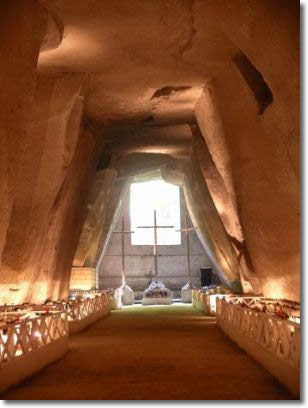
- The Fontanelle cemetery
At one time, funeral processions would pass through the Tuff Gate, now known as San Gennaro Gate, (near Via Foria) to bury their loved ones outside the city walls. From IV century B.C. to the Paleochristian period, people used to dig their tombs and hypogeums in the Sanità valley, as is demonstrated by the San Gennaro, San Gaudioso and San Gennaro catacombs and the many hypogeums, monument-type burial chambers, which can be found all over the Sanità (there is an example in Via Cristallina n° 133). From the year 600 onwards, the pits which had been dug by the Greeks for other purposes e.g. to quarry stone for building, were used as cemeteries for the poor or for plague victims, or as dumps for all the bones from the Holy Land which Neapolitan churches needed to get rid of for reasons of space.
The Fontanelle Cemetery under the Capodimonte hill is a good example. Our itinerary could start at the Tuff Gate, cut across the square and go down Via Vergini and then carry on along Via Sanità until we get to the Fontanelle Cemetery. As we leave the square in front of the St. Maria della Sanità church we find a street at right angles to it of the same name.
There is a lift in the square which takes you up to Corso Amedeo di Savoia and you can carry on from there to the San Gennaro catacombs. This was originally the Saint's family tomb but after the martyr's burial it became an important Christian burial site and an important testimony of early Christianity in Naples.
The gardens opposite offer a taste of the kind of peace you will find in the wonderful huge park just metres away. Capodimonte woods are a great place to relax and enjoy yourself away from the stress and chaos of the city. It's a perfect place to finish our long walk through moments of history dating back thousands of years.